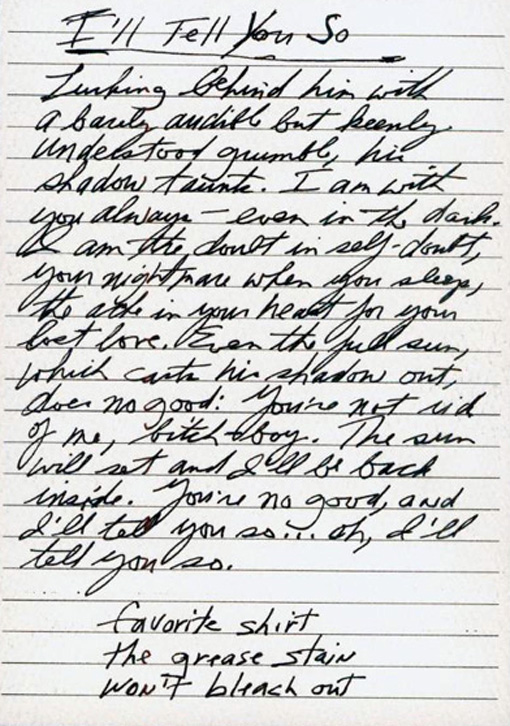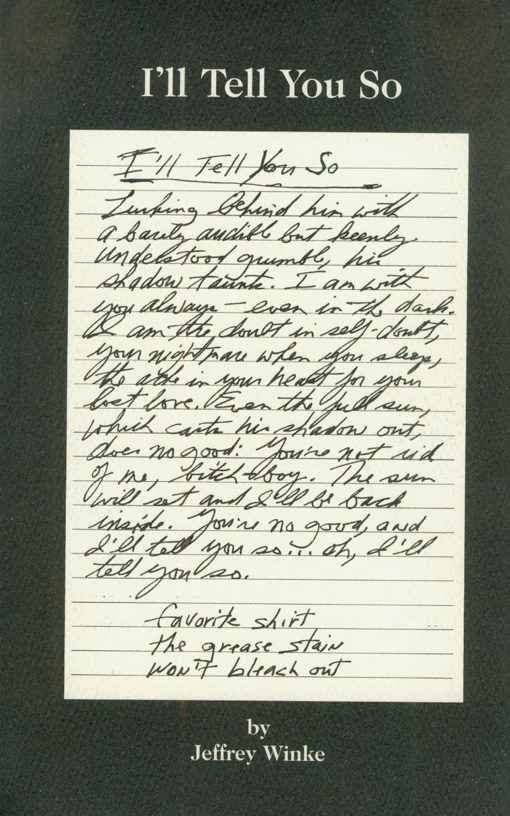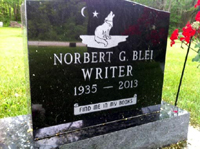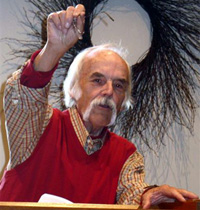Poetry Dispatch No.324 | June 28, 2010
JEFFREY WINKE: Review
Editor’s Note: As the book review pages of major and minor newspapers and periodicals dwindle in today’s high-tech/non-reading culture, it’s difficult enough to land a review of any significant book, let alone an insightful reviewer who understands the art of the review-essay. With that in mind, it’s damn near impossible to find a small, independent press receive a line of ink anywhere but old fashioned little magazines (the conscience of American literature) and some superb online literary sites such as Jeffery Woodward’s excellent site, http://haibuntoday.com devoted to the haibun.
In the early days of Cross+Roads Press (well over ten years ago) I was fortunate to occasionally receive a review of the books I was publishing in the local newspaper, The Door County Advocate. But that was under the independent ownership of the publisher/editor, Chan Harris, who happened to be a literary guy and was very supportive of the arts in this community. That all disappeared once the Gannett Corp. began its take-over of every local newspaper it could gobble up. These days, I’m forever thankful (as many of us small press writers and publishers are) for all the effort and work that Wisconsin writer, Charles Ries, does to distribute his reviews of countless important small press books to many fine print and online publications throughout the country.
I’m thankful as well to Jeffrey Woodward and the reviewer, Tish Davis, for the thoughtful and incisive review of Cross+Roads Press author, Jeff Winke’s new book of haibun that recently appeared in Haibun Today. –Norbert Blei
![]()


Review of Jeffrey Winke’s I’ll Tell You So
by Tish Davis
Dublin, Ohio, USA
I’ll Tell You So by Jeffrey Winke. Ellison Bay, WI: Cross+Roads Press, 2010. 5” x 8,” perfect bound, 102 pp. ISBN: 978-1-889460-23-9. $12.00 USD.
The eighty-five works in Jeffrey Winke’s first collection of haibun are fresh and innovative, portraying scenes and characters, whether real or imagined, from middle-class America. Winke capitalizes on the ordinary, offering first and third person narratives—snippets of characters and their conflicts—presented in ways that evoke compassion, a smile and sometimes a full belly laugh.
The haibun in the book are not arranged in thematic sections but, based upon their titles, in alphabetical order. Before reading the book from cover to cover, I found myself making initial selections by skimming through the titles such as “Electric Green Chokers,” “Hunchback With the Toy Poodle,” and “Reflective Tape Stripes Around Each Leg.” I quickly observed that Winke pulls his titles directly from the prose—something typically frowned upon in haibun. However, this did not deter my enjoyment of these works whose characters include a young couple awaiting passage at a security crossing, a group of friends enjoying a Wednesday night dinner, and Ernest, the parking lot attendant.
These selections are typical of a style that allows the reader to enter the piece from whatever vantage point he chooses. Sometimes the reader might recognize a friend or an acquaintance; sometimes the reader might see himself. Often these outcomes reveal weaknesses in the human condition and Winke uses that to make the reader both reflect on the situation and to laugh. Consider “Reflective Tape Stripes Around Each Leg” (70), for example. Even though the description focuses on Ernest, there’s also an implicit connection with the silver-haired executive and his date:
With the 18-inch red glowing parking wand visible, the stout presence of Ernest stands solid in the dark boulevard wearing his fluorescent-yellow breathable safety pants with two horizontal reflective tape stripes around each leg that makes him feel god-like powerful while directing the steady flow of luxury automobiles streaming their headlights into the gated parking lot where he occasionally—just for fun—halts a shiny black Jaguar XK to a full stop to leer at the strapless twenty-something trophy sitting in the passenger seat while growling, “ you gotta slow down, bud-DEE” to the silver-hair captain of industry who glares at Ernest with utmost contempt.
closing time bartender
collects empties
filled with stories
The leap from prose to haiku is very effective. Winke’s intentional ambiguity allows the reader to become both observer and participant. As the light dims, the reader can reflect on what version of the story the characters in the haibun might have told or the setting can revert to a bar perhaps familiar to the reader, and to stories known only to him.
Winke’s haibun average 150 words and all are written as a basic unit of one paragraph followed by one haiku. The settings vary but are typically mundane, ordinary places such as the office, kitchen, or laundry mat. Several haibun take place in bars, diners, night clubs or restaurants. However, this is by no means an indication of cookie-cutter haibun where writers, upon finding a successful formula, merely replicate a previous success. Winke’s variations are proof of a writer who knows what he wants to achieve.
In “Tilted at a Severe Angle” (86), one of my favorites, Winke’s use of tight, but figurative prose places the reader in a jazz club just as a sultry blonde arrives:
She sits at the bar next to Lamont. His black fedora tilted at a severe angle. She isn’t here for Lamont. Her snug blouse is open enough to the neck to show part of a spider web tattoo that flourishes behind soft cotton. She lights up a long-filtered cigarette, draws deeply, and swivels her dark-eye gaze to the sax player. With lips slightly parted, she exhales completely. The saxman nods recognition before bending his alto into one last passion sizzler that eventually melts back into a sweaty finale.
just barely
her breasts
in my space
The shift from the suggestive exchange between the blonde and saxman to the narrator is deftly handled with its implication of pheromonal influence. Although the title again is drawn from the prose (and yes one could argue that it could be deleted without loss), one can also assume that the narrator has readjusted his position on the bar stool in order to get a better view, thus allowing this phrase to serve a dual purpose.
In “I believe I am” (46), Winke again pulls his title from the prose, but here, it did not balance the piece nor did it strengthen a work that I found to be too introspective. The haibun begins:
I figured it out. I think. My life is a mystery novel. There are plots, sub-plots, and intriguing side characters who, at first, appear to be more prominent than they are. Things unfold for little reason at all, so it seems.
As the haibun progresses, the narrator, who doubles as protagonist in the imaginary novel, confesses that when he can no longer control the variables in life, he “holds his breath and waits for the narrator to jump in and add a sense of calm to the situation.”
The most promising part of this composition is the concluding haiku, but it failed to compensate for the deficiencies in the prose:
bigger, stronger–
that’s what the spam says
so it’s true
Winke’s voice is one we’ve come to recognize as light and witty. Even the best stand-up comic falls flat occasionally, so the reader should not be unduly disappointed by the few works in I’ll Tell You So that did not hit their mark.
The strengths in this collection are the third person narratives. “A Jar of Paint,” “Bait Floats to the Bottom,” “Below the Shallow Arc,” “Every Night and First Words,” “In a Slurred-Word State,” and “Slides Into the Keyway” are a few that come to mind. Here, the images linger and, when reread, can be enjoyed again as if one is meeting the characters for the first time.
Winke is at his best when the pathos is subdued and is combined with his lightness and wit. Consider “Thinks While Growing Impatient” (85), a work that on a first read might easily be dismissed as “alien humor.”
The crinkle sound is barely audible, but the dog hears it and perks her ears. The tall alien is preoccupied. With one of several lipless mouths it’s busy chewing on a one-pound bag of Twizzlers® artificially-flavored cherry bites—red licorice. Its content-analyzing mastication glands find little nutritional value. “Another oddity,” it muses . . . when it hears the low rumbling growl of the dog slowly padding down the carpeted hallway under a gallery of family photos—everyone looks happy, even Uncle Gary who had bit the end of a Glock last year. “Any time Anja,” the tall alien thinks while growing impatient at the designated pick-up point on the designated day at the exact designated time.
brisk rain—
she protects a letter
to an old friend
I enjoyed the image of the alien eating candy that’s artificially flavored, perhaps a little envious of the family whose portraits hang in the hallway. Of course, he probably has no way of knowing that their smiles are artificial too. Winke asks the reader, “What is real?” He provides the answer in the haiku that closes this evocative haibun.
I’ll Tell You So is a collection that can be read and reread, enjoyed “as is” or studied for its contemporary techniques. The cover is avant-garde, but the book’s roots are traditional, revealing American characters and themes uniquely presented by a fine writer.
[from: A Quarterly Journal, Jeffrey Woodward, Editor. Volume 4, Number 2, June 2010]


Jeffrey Winke by Jeffrey Winke




























































Thank you, I really love this story I appreciate
what you are doing for the poetry.
Please visit my website:
http://galleryofthemind.com/
Where Beauty And Darkness Meet Book/CD Trailer:
Where Beauty And Darkness Meet CD:
http://galleryofthemind.com/SC_webpage/shoppingcart_CD_WBDM.htm
Where Beauty And Darkness Meet Book:
http://galleryofthemind.com/SC_webpage/shoppingcart_WBDM.htm
we offer a free e-book or CD copy of the book…
please visit my website:
http://galleryofthemind.com/
“Can be read and reread” indeed. But a mistake, I think, to try and read right through. Better to read one selection at a time; to chew on one of Winke’s expertly cooked dishes thoroughly, savoring fully before moving on to the next course. A piece or two a day works for me. He is a master of dry humor and human observation and takes haibun and haiku to a place none of us has been before. Buy this book. Read and reread.
Thanks Ralph and Greg for your kind words. Very nice… very nice, indeed.
It’s an interesting experience to read Jeff’s creative writing view his skills through the eyes of another person. The review is almost as enjoyable as the book reviewed but not nearly as enjoyable as the wit and charm of its author.